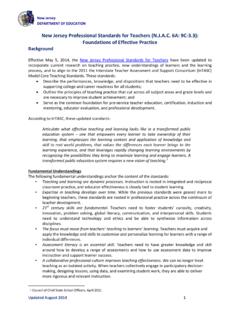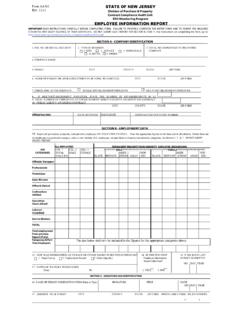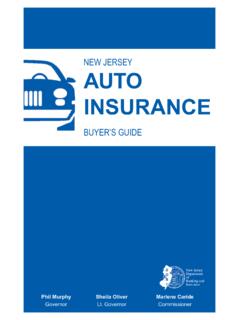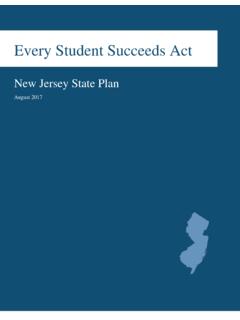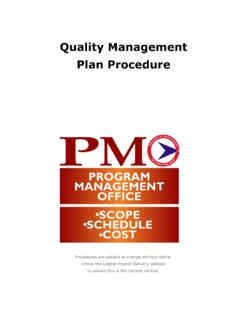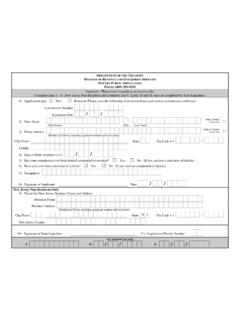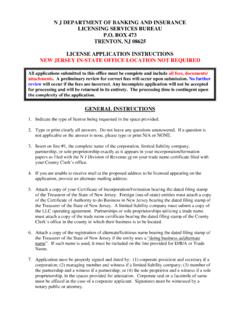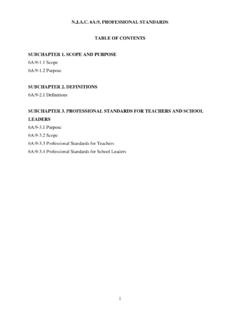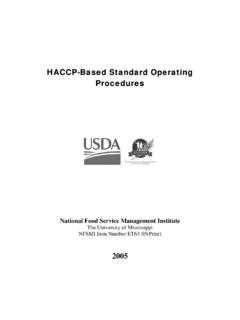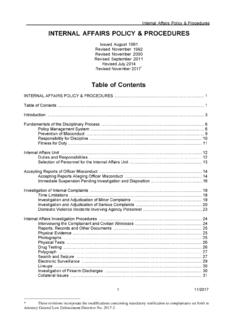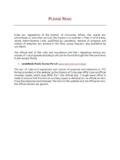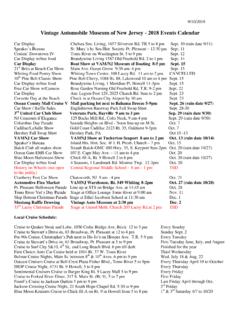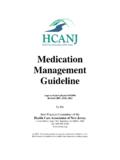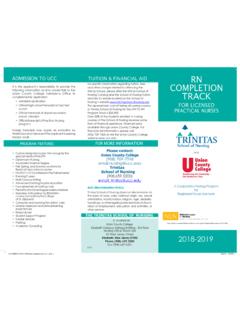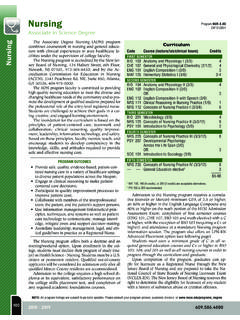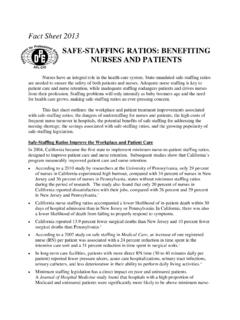Transcription of NEW JERSEY MEDICAID PROGRAM ELIGIBILITY
1 PROGRAM ELIGIBILITY 4 page Revised 6/12/09 NEW JERSEY MEDICAID PROGRAM ELIGIBILITY New JERSEY MEDICAID covers persons who are age 65 years or over and persons determined blind or disabled by the Social Security Administration or by the Division of Medical Assistance and Health Services. The individual must be a resident of New JERSEY and a citizen of the United States or lawfully admitted for permanent residence. COMMUNITY MEDICAID : An individual is eligible for community MEDICAID in New JERSEY if his/her gross monthly income is equal to or less than $903 (the first $20 per month of income is excluded).
2 Income includes, but is not limited to, Social Security income, veterans' benefits, pensions, annuities, interest, dividends, and payments from trust funds, and rental income from real property. The current MEDICAID resource maximum for an individual is $4,000. Countable resources include, but are not limited to, bank accounts, property other than principal residence, stocks, bonds, certificates of deposit, annuities, and cash surrender value of life insurance which exceeds $1,500 in face value. Excludable resources include, but are not limited to, a home which serves as the individual's principal residence, life insurance which does not exceed $1,500 in face value, burial spaces, and burial funds not exceeding $1,500 (less excluded cash surrender value of life insurance and/or funds held in an irrevocable burial arrangement), one automobile to the extent that its current market value does not exceed $4,500, and one wedding and engagement ring.
3 INSTITUTIONAL MEDICAID : In order to qualify for payment of institutional benefits, for example nursing facility care, under the MEDICAID PROGRAM in New JERSEY , an applicant must meet not only the financial criteria, but also the medical necessity requirements. Each of these ELIGIBILITY processes is complex and must be evaluated according to the applicant's individual circumstances. Considering these complexities, the general information which is being provided should only be used as a guideline. The current MEDICAID ELIGIBILITY income standard for an institutionalized individual is $2,022 per month.
4 If an individual's gross monthly income exceeds this MEDICAID "cap," he or she is income ineligible for MEDICAID . Income includes, but is not limited MEDICAID ELIGIBILITY Page 2 to, Social Security income, veterans' benefits, pensions, annuities, interest, dividends, payments from trust funds, and rental income from real property. Once ELIGIBILITY is established, full MEDICAID coverage is provided. However, the individual's income must be applied to offset the cost of nursing facility care. There are two MEDICAID resource ELIGIBILITY standards depending on the individual's income.
5 If an individual's gross monthly income is below $903 (the first $20 per month of income is excluded), the current MEDICAID resource maximum is $4,000. If an individual's gross monthly income is between $ and $2,022, the current resource maximum is $2,000. Countable resources include, but are not limited to, bank accounts, property other than principal residence, stocks, bonds, certificates of deposit, and cash surrender value of life insurance which exceeds $1,500 in face value. Excludable resources include, but are not limited to, a home which serves as a principal residence of a spouse or other dependent relative (if a home is not occupied by a dependent relative and the period of institutionalization is expected to be six months or less, the home may also be excluded)
6 , life insurance which does not exceed $1,500 in face value, burial spaces, and burial funds not exceeding $1,500 (less excluded cash surrender value of life insurance and/or funds held in an irrevocable burial arrangement), one automobile to the extent that its current market value does not exceed $4,500, and one wedding and engagement ring. The spousal impoverishment provisions of the Medicare Catastrophic Coverage Act of 1988, effective October 1, 1989, provide that, if the individual requiring institutional services is married, the total countable resources of both members of the couple are counted except for those resources which are protected for the community spouse.
7 The amount of resources which may be protected for the community spouse is the greater of 1/2 of the couple's resources or $21,912, not to exceed $109,560. Once ELIGIBILITY is established for the institutionalized individual, the community spouse's resources are no longer counted. For married individuals whose current period of institutionalization began before September 30, 1989, resources may not be set aside for the community spouse and ELIGIBILITY will be determined for the institutionalized individual counting only those resources owned by him or her.
8 The spousal impoverishment provisions of the Medicare Catastrophic Coverage Act of 1988 also provide that a penalty period of ineligibility for only institutional services will be imposed on those individuals who have transferred any resources for less than fair market value prior to the date of application for MEDICAID . The look back period for the establishment of a trust is 60 months preceding the date of application for MEDICAID . On February 8, 2006, the provisions of the Deficit Reduction Act of 2005 allowed the period of ineligibility for resource transfers to be determined by dividing the uncompensated value of the transferred resource, which is also, know as the penalty divisor.
9 The monthly penalty divisor is $7,282. The daily penalty divisor is $ , which is used to calculate days of ineligibility. There is also a progressive look back period commencing February 2009. Additional months will be added to the look back period until February, 2011, when a full 60 month look back period will be in effect. MEDICAID ELIGIBILITY Page 3 In addition, the spousal impoverishment provisions of the Medicare Catastrophic Coverage Act of 1988 provide that a deduction may be made from an eligible institutionalized individual's income, prior to the application of income to the cost of care, for the maintenance of the community spouse.
10 The basic community spouse deduction is $1, per month. However, it is reduced by the community spouse's gross income, both earned and unearned. If the community spouse's shelter expenses exceed $ monthly, the community spouse s maintenance deduction limit will be increased by the amount of the excess. The amount of income made available to the community spouse is limited by the income of the institutionalized spouse, not to exceed $2,022 per month, less a personal needs allowance of $35. NEW JERSEY MEDICAID programs - MEDICALLY NEEDY SEGMENT: An individual seeking institutional MEDICAID whose income exceeds the MEDICAID "cap" of $2,022, may be eligible for limited MEDICAID coverage through the Medically Needy component of New JERSEY MEDICAID programs .
